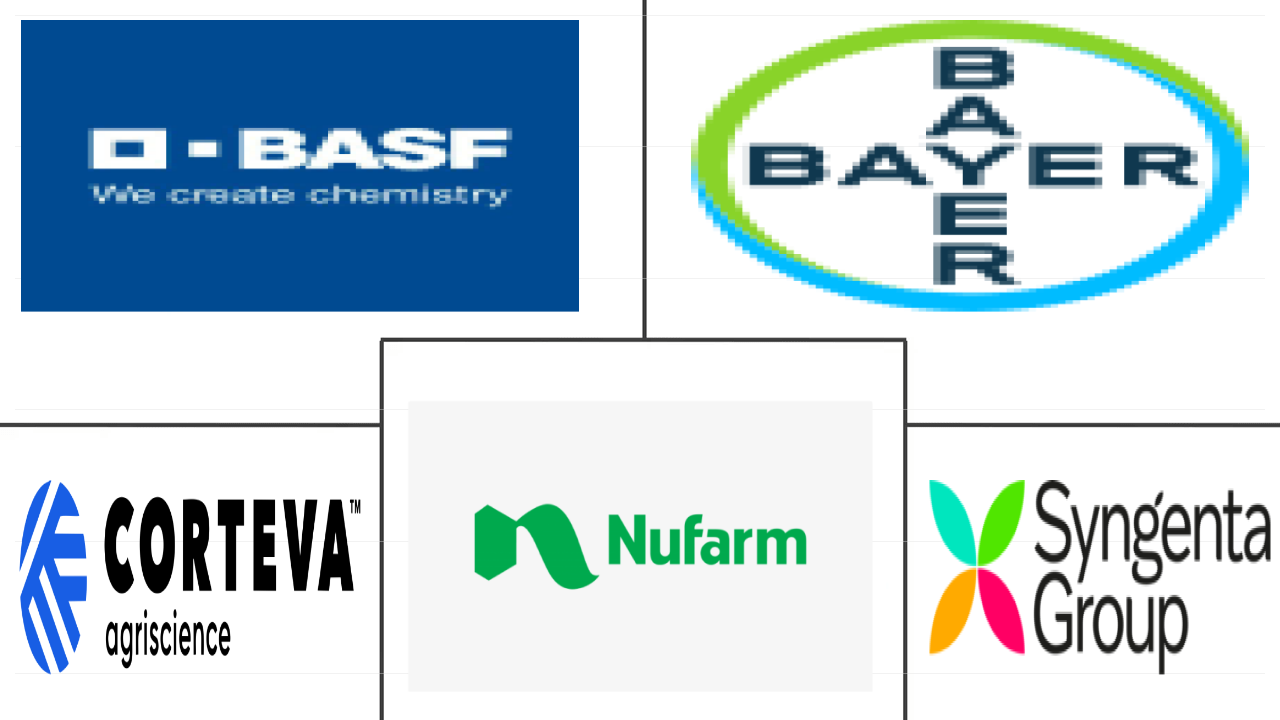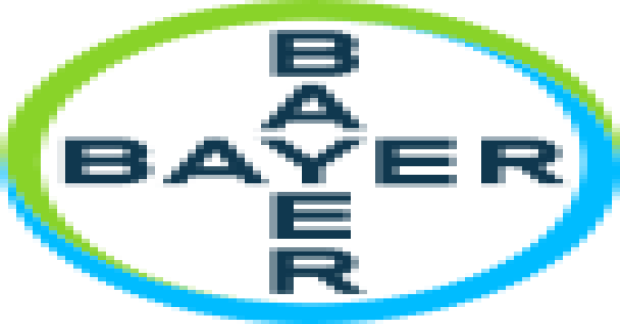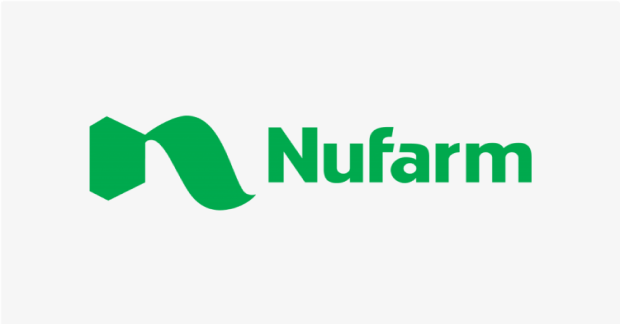Market Size of uk crop protection chemicals Industry
|
|
Study Period | 2017 - 2029 |
|
|
Market Size (2024) | USD 359.41 Million |
|
|
Market Size (2029) | USD 405.89 Million |
|
|
Largest Share by Function | Fungicide |
|
|
CAGR (2024 - 2029) | 2.46 % |
|
|
Fastest Growing by Function | Molluscicide |
Major Players |
||

|
||
|
*Disclaimer: Major Players sorted in no particular order |
UK Crop Protection Chemicals Market Analysis
The UK Crop Protection Chemicals Market size is estimated at 359.41 million USD in 2024, and is expected to reach 405.89 million USD by 2029, growing at a CAGR of 2.46% during the forecast period (2024-2029).
359.41 Million
Market Size in 2024 (USD)
405.89 Million
Market Size in 2029 (USD)
-1.18 %
CAGR (2017-2023)
2.46 %
CAGR (2024-2029)
Largest Segment By Function
52.96 %
value share, Fungicide, 2023
Increasing incidences of fungal diseases in major crops like wheat and potatoes emphasize the need for the usage of fungicides for better control and crop production.
Fastest-growing Segment by Function
5.23 %
Projected CAGR, Molluscicide, 2024-2029
The rise in damages caused by garden snails, glass snails, and slugs in various crops, including fruits, vegetables, and ornamental crops, is boosting the growth of the molluscicides market.
Largest Segment by Crop Type
69.36 %
value share, Grains & Cereals, 2023
Extending cultivation areas and intensive agriculture practices to meet domestic and international demands has increased the crop protection chemicals used in this segment.
Leading Market Player 1
15.28 %
market share, Bayer AG, 2022

Bayer Crop Science provides crop protection chemicals with the objective of offering safe and high-quality products that contribute toward sustainable agriculture.
Leading Market Player 2
14.18 %
market share, Nufarm Ltd, 2022

Nufarm majorly concentrates on extending its product portfolio by partnering with companies like Sumitomo Chemicals and adding the new fungicide product metyltetraprole to the market.
Increasing pests and disease infestations in the country are leading to severe yield losses and driving the market for different crop protection chemicals
- The UK fungicide market was valued at USD 182.9 million in 2022. It was the most consumed among crop protection chemicals, with a market share of 53.2% in the same year.
- The most extensively used fungicide formulations in the United Kingdom include chlorothalonil, epoxiconazole, prothioconazole, and tebuconazole. Septoria tritici is UK wheat's most damaging foliar disease, causing yield losses that range from 30% to 50% in high-pressure seasons. Many wheat growers have increased the use of fungicides in their crops to mitigate yield loss.
- Weeds impact UK crops like cotton and winter wheat. They cause a 30% yield loss in cotton, the main fiber crop. Black grass (Alopecurus myosuroides), a native weed, frequently infests UK farms. Severe infestations force farmers to abandon winter wheat, the main cereal crop. Weeds compete for resources, hinder crop growth, and reduce yields, causing economic losses and leading to the adoption of herbicides. Herbicides accounted for 38.2% of the UK crop protection chemicals market in 2022.
- The changing climate and rising temperatures are causing an increase in the population and feeding habits of insect pests. A study reveals that as heat stress on crops intensifies, cereal yields in the United Kingdom are projected to decline by approximately 10% with a 2 °C increase in temperature. Consequently, these circumstances are prompting farmers in the country to rely on insecticides to manage pest pressures.
- Increasing pests and disease infestations in the country have led to severe yield losses, thus driving the market for different crop protection chemicals based on farmers' needs. The market is estimated to register a CAGR of 2.4% during the forecast period (2023-2029).
UK Crop Protection Chemicals Industry Segmentation
Fungicide, Herbicide, Insecticide, Molluscicide, Nematicide are covered as segments by Function. Chemigation, Foliar, Fumigation, Seed Treatment, Soil Treatment are covered as segments by Application Mode. Commercial Crops, Fruits & Vegetables, Grains & Cereals, Pulses & Oilseeds, Turf & Ornamental are covered as segments by Crop Type.
- The UK fungicide market was valued at USD 182.9 million in 2022. It was the most consumed among crop protection chemicals, with a market share of 53.2% in the same year.
- The most extensively used fungicide formulations in the United Kingdom include chlorothalonil, epoxiconazole, prothioconazole, and tebuconazole. Septoria tritici is UK wheat's most damaging foliar disease, causing yield losses that range from 30% to 50% in high-pressure seasons. Many wheat growers have increased the use of fungicides in their crops to mitigate yield loss.
- Weeds impact UK crops like cotton and winter wheat. They cause a 30% yield loss in cotton, the main fiber crop. Black grass (Alopecurus myosuroides), a native weed, frequently infests UK farms. Severe infestations force farmers to abandon winter wheat, the main cereal crop. Weeds compete for resources, hinder crop growth, and reduce yields, causing economic losses and leading to the adoption of herbicides. Herbicides accounted for 38.2% of the UK crop protection chemicals market in 2022.
- The changing climate and rising temperatures are causing an increase in the population and feeding habits of insect pests. A study reveals that as heat stress on crops intensifies, cereal yields in the United Kingdom are projected to decline by approximately 10% with a 2 °C increase in temperature. Consequently, these circumstances are prompting farmers in the country to rely on insecticides to manage pest pressures.
- Increasing pests and disease infestations in the country have led to severe yield losses, thus driving the market for different crop protection chemicals based on farmers' needs. The market is estimated to register a CAGR of 2.4% during the forecast period (2023-2029).
| Function | |
| Fungicide | |
| Herbicide | |
| Insecticide | |
| Molluscicide | |
| Nematicide |
| Application Mode | |
| Chemigation | |
| Foliar | |
| Fumigation | |
| Seed Treatment | |
| Soil Treatment |
| Crop Type | |
| Commercial Crops | |
| Fruits & Vegetables | |
| Grains & Cereals | |
| Pulses & Oilseeds | |
| Turf & Ornamental |
UK Crop Protection Chemicals Market Size Summary
The UK Crop Protection Chemicals Market is experiencing a steady growth trajectory, driven by the increasing need to combat pests, diseases, and weeds that threaten agricultural productivity. The market is characterized by a significant reliance on fungicides, herbicides, and insecticides to mitigate yield losses in key crops such as wheat and cotton. The use of fungicides is particularly prominent due to the prevalence of diseases like Septoria tritici, which severely impacts wheat yields. Herbicides are essential for managing weed infestations, such as black grass, which can lead to substantial economic losses. The changing climate and rising temperatures are exacerbating pest pressures, prompting farmers to adopt more crop protection chemicals to safeguard their yields. Despite the growth, there is a noticeable shift towards sustainable practices and integrated pest management, influenced by government initiatives aimed at reducing pesticide usage.
The market landscape is moderately consolidated, with major players like BASF SE, Bayer AG, Corteva Agriscience, Nufarm Ltd, and Syngenta Group dominating the sector. These companies are actively investing in innovative technologies and partnerships to develop eco-friendly and effective crop protection solutions. The adoption of non-chemical alternatives and the withdrawal of certain active substances are contributing to a gradual decline in pesticide consumption per hectare. However, the demand for specific chemicals like glyphosate and imazalil remains robust, driven by their effectiveness in weed control and disease management. The market's growth is further supported by strategic collaborations and technological advancements aimed at addressing the evolving challenges in crop protection.
UK Crop Protection Chemicals Market Size - Table of Contents
-
1. MARKET SEGMENTATION (includes market size in Value in USD and Volume, Forecasts up to 2029 and analysis of growth prospects)
-
1.1 Function
-
1.1.1 Fungicide
-
1.1.2 Herbicide
-
1.1.3 Insecticide
-
1.1.4 Molluscicide
-
1.1.5 Nematicide
-
-
1.2 Application Mode
-
1.2.1 Chemigation
-
1.2.2 Foliar
-
1.2.3 Fumigation
-
1.2.4 Seed Treatment
-
1.2.5 Soil Treatment
-
-
1.3 Crop Type
-
1.3.1 Commercial Crops
-
1.3.2 Fruits & Vegetables
-
1.3.3 Grains & Cereals
-
1.3.4 Pulses & Oilseeds
-
1.3.5 Turf & Ornamental
-
-
UK Crop Protection Chemicals Market Size FAQs
How big is the UK Crop Protection Chemicals Market?
The UK Crop Protection Chemicals Market size is expected to reach USD 359.41 million in 2024 and grow at a CAGR of 2.46% to reach USD 405.89 million by 2029.
What is the current UK Crop Protection Chemicals Market size?
In 2024, the UK Crop Protection Chemicals Market size is expected to reach USD 359.41 million.

